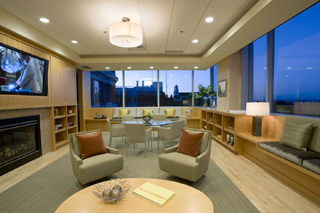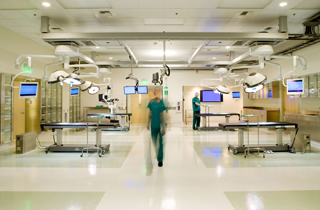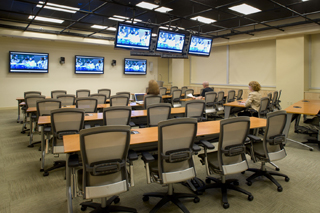|
Subscribe / Renew |
|
|
Contact Us |
|
| ► Subscribe to our Free Weekly Newsletter | |
| home | Welcome, sign in or click here to subscribe. | login |
Architecture & Engineering
| |
July 9, 2008
AIA Project of the Month: Virtual surgery center offers real training for doctors
Special to the Journal
When you enter the Seattle Science Foundation's grand waiting room only glass walls stand between you and a surgery suite. It's all there — the gurneys, the lights, the plethora of screens as well as many mechanical and electronic devices. Oh, and real doctors are everywhere.
It looks more like a TV studio than a hospital and, in a way, it is. There are no real patients.
Instead, it's a kind of virtual medical world, where doctors from around the globe meet and exchange cutting-edge ideas, technical knowledge and practical information. A typical event is a three-day medical conference on new techniques in surgery.
“Our job was to make a professional environment — and a clinical environment and a teleconferencing environment,” said project designer Sarah Reisenauer of CollinsWoerman. And it's all there, everything you would need for surgery, office space, conferencing and teleconferencing. But there is also room to relax.
| Seattle Science Foundation 550 17th Ave. |
|
CollinsWoerman Bev Tiedje, project manager Sarah Reisenauer, project designer Kevin Otteson, project architect Building owner: Sabey Corp. Project type: Research and educational laboratory Size: 16,600 square feet Completion: April 2007 Construction cost: $2.8 million Structural engineer: KPFF Electrical engineer: VECA Electric Mechanical engineer: McKinstry Co. IT/Communication: Pacific Northwest Gigapop University of Washington Computing and Communication General contractor: Sabey Construction Jury comments: “Human interaction and learning are incorporated into a design that considers the future of health care.” “I am squeamish, but I think I’d actually like watching someone else get operated on in this facility. Who ever thought operating rooms could be so fun?” “Simply exceptional integration of technology in an educational facility. The state-of-the-art medical technology is one with the space rather than taking center stage.” |
“This is not just some classroom in the back of a hospital,” said project manager Bev Tiedje.
It's more like a model unit in an upscale housing complex. There's a library and club room with a lodge-like fireplace between, and a sweeping view of the Cascades.
The glass walls around the virtual surgery suite are designed to be a metaphor for the transparency of the medical knowledge being created there. These walls, and the technologies on view, make a sharp contrast with the warm colors, solid materials and comforts of the seating and club areas.
The foundation, started in the spring of 2006, is not a clinic or a laboratory or a medical institution in any conventional sense of the word. What it is, according to Executive Scientific Director Robert Franza, is an entirely new idea, borne of modern frustrations and dreams.
The frustration is with the burdens education places on medical institutions, burdens that can hamper advances in technology and practice, and keep potential teachers in their respective silos.
“When a physician is teaching other physicians, nobody's billing,” Franza said.
In order to leverage the rich resources of the region — a critical mass of prestigious educational and medical institutions and biotechnical research firms — it was clear to Franza that “something independent was going to have to be created.”
The dream took off with the support of real estate entrepreneur David Sabey, who owns the building, and architect Arlan Collins, co-founder of CollinsWoerman. They began to talk about possibilities for creating a center where people in the forefront of medical knowledge could meet and interact, and creating a technology platform that would allow them to preserve those interactions as a resource and reference.
Franza was inspired by technical advances in architecture. Take the Experience Music Project, for example, with its wildly sculptural form. “Not one piece of steel is like another piece of steel but they all arrive at the site and fit together.” Thinking about the construction of Frank Gehry's building got him thinking about improving the ways that medical knowledge is shared, and medical services are delivered.
The specialists that make the breakthroughs in medical knowledge and technique, especially in areas like endovascular surgery, cannot be everywhere at once. But the Seattle Science Foundation might be the breakthrough that makes it happen. “We can multiplex that person,” said Franza.
The “multiplex” begins inside the foundation itself. The glass-enclosed suite is a place where everyone, the public and the expert, can observe the use of simulation systems in professional education and the use of robotics in surgery.
Then there's a full-fledged “cadaveric” operating theater, where hands-on training takes place. In the large classroom/conference room, up to 50 visitors can view intricate procedures, in real time or recorded, on multiple rows of screens suspended from the ceiling. At the same time, participants in remote sites can view the same procedures, or take part in panels or other group events. Integrated telecommunications enable large group interaction on a world-wide scale.
The foundation occupies about a quarter of the sixth floor of James Tower, the 1910 building in the heart of the Swedish Medical Center/Providence, a building Sabey bought back in 2002 along with about 40 percent of the campus. The building was “cored” and rebuilt to current seismic standards.
Sabey renovated all of it with an eye to the future of medicine. It is now home to a lab company, a medical device incubator, a cardiovascular wellness center, and Seattle University's College of Nursing. Acciun Biosciences has a linear accelerator on the seventh floor.
During the design and planning phase, the architect and developer toured research and teaching facilities including the Mayo Clinic, Cleveland Clinic, Johnson & Johnson's Ethicon, and the University of Chicago School of Medicine. Design concepts were reviewed by members of some of these institutions and others.
It's designed not only to disseminate knowledge, but also to gather it. “We've been picking some very, very difficult problems,” said Franza.
The board of the foundation reads like a who's who of hospitals in the Northwest. According to Franza, “It was about a coming together of organizations that share a vision for the future of the region,” institutions that occasionally compete with one another.
Sabey is president of the board. “Dave (Sabey) calls it Switzerland,” said Franza, a reference to the neutrality and opportunity of the place.
“I call it Constantinople,” he said, referring to the ancient city where the Byzantine culture bridged over to the Greek, and all the known languages at the time were readily translated from one to another.
The Project of the Month is sponsored by the Daily Journal of Commerce and the Seattle chapter of the American Institute of Architects. The Project of the Month for July was selected with the assistance of UW professor Eddy Rojas, landscape architect Michele Arab and architect Ron Van der Veen. For more information about submitting projects, contact Stephanie Pure at AIA Seattle, (206) 448-4938, or stephaniep@aiaseattle.org.
Clair Enlow can be reached by e-mail at clair@clairenlow.com.
Previous columns:
- AIA Project of the Month: Live Aboves: A wise, modest project meets its lofty goals, 05-14-2008
- AIA Project of the Month: Flexibility, durability and a place kids call their own, 04-09-2008
- AIA Project of the Month: The winery gets reinvented in Woodinville, 03-12-2008
- AIA Project of the Month: A shell and more that 'parties fantastically', 02-13-2008
- AIA Project of the Month: Agnes Lofts: it's the windows, 01-16-2008
- AIA Project of the Month: Alley 24: A lab for redevelopment, 12-12-2007
- AIA Project of the Month: Bringing science and sea together, in the woods, 11-14-2007
- AIA Project of the Month: SSCC center: a zipper to bring campus together, 10-10-2007





